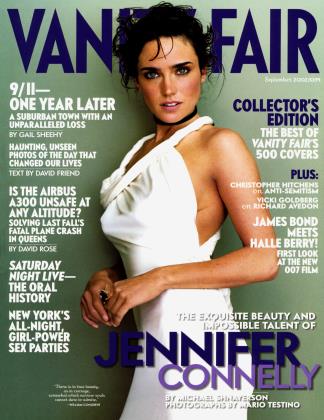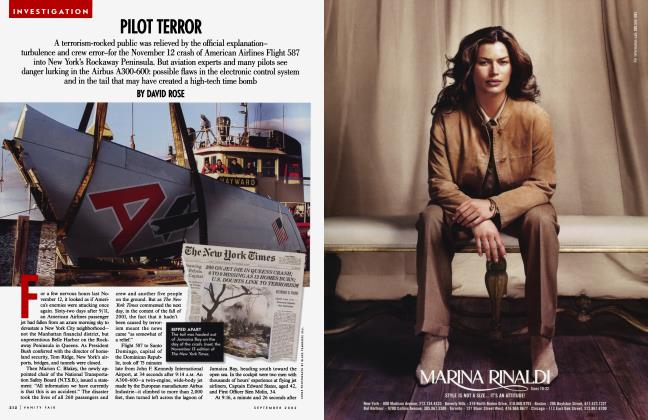Sign In to Your Account
Subscribers have complete access to the archive.
Sign In Not a Subscriber?Join NowCONTRIBUTORS
Vanity Fair's editor of creative development, David Friend, has edited a good deal of the magazine's September 11 coverage. Not surprising, given that Friend, as a Life correspondent in the 80s, reported on conflicts in Afghanistan and Lebanon, filed stories from Kuwait, Oman, Tunisia, and the West Bank, and once tailed the Jerusalem bomb squad. On page 326, he writes about photography's pivotal role during and after the World Trade Center assaults. "I first saw the attacks in photographs," he recalls, "in eerie triplicate on three large video screens in Times Square." Friend and V.F. editor Graydon Carter were executive producers of the film 9/11—nominated for five Emmys— which will air this month on CBS and be broadcast to some 120 countries.
Special correspondent Amy Fine Collins has the ultimate compliment to pay architect-decorator Robert Couturier, whom she has known for 12 years. "Robert is an original thinker—a poet of color and philosopher of space," says Collins. "His work hasn't been taken seriously enough before because he doesn't take himself seriously—and that is part of his charm." Couturier's client list includes a sophisticated, international mix of people, such as newspaper heiress Anne Hearst and writer Andrew Solomon. His collaboration with the late financier Sir James Goldsmith produced Cuixmala, Goldsmith's exotic compound in a remote part of Mexico. "It's really Robert's moment," says Collins, whose article on Couturier begins on page 236. "He's at the pinnacle of his career."
This fall marks the publication of Live from New York, an oral history of Saturday Night Live, by James Andrew Miller and Tom Shales, excerpted on page 356. Culling the uncensored memories of cast members, writers, and crew seemed to take forever. "We pulled out of Vietnam faster," says Miller (far left), author of Running in Place: Inside the Senate (1986). "It was painstaking but, ultimately, incredibly rewarding." Shales, the Pulitzer Prize-winning television critic at The Washington Post, agrees. "It's a study of people with talent," he says. "And people with talent have special demons, which is, to me, very moving. With cases like Chris Farley, John Belushi, and Gilda Radner, it was a lot more dramatic than I thought it would be. I thought it'd be a million laughs, but it was a million tears too."
FOR DETAILS, SEE CREDITS PAGE
Vicki Goldberg first encountered Richard Avedon's work when she was "a teenager looking at fashion magazines," but it was his portrait show at New York's Marlborough Gallery in 1975 that stayed with her. "It's fascinating to me that it's almost 30 years ago and I still remember certain things about that show quite vividly," says Goldberg, whose article on Avedon begins on page 346. Goldberg, who has written about Walker Evans, Ansel Adams, and Brassai' for V.F., also writes about photography for The New York Times and is the author of The Power of Photography.
George Orwell once advised a friend never to write anything about Israeli or Jewish questions, because the chance of making enemies was just too high. Christopher Hitchens, who writes this month about Israel and anti-Semitism, is publishing a new book this fall, Why Orwell Matters (Basic Books). "Orwell didn't take his own advice: he was a stern foe of anti-Semitism and had serious doubts about the wisdom of Zionism. So, since I have enough enemies already, I thought I'd look at the origins of an argument that now involves everybody."
CONTINUED ON PAGE 129
CONTINUED FROM PAGE 122
This month, contributing editor Nancy Jo Sales visits Midtown's hippest hotel, the W, for an evening of dirty dancing, striptease, and sexual pursuit, mainly girl-on-girl. It's called a Cake party, and it's the latest hedonistic phenomenon to hit mainstream Manhattan. To get invited, the girls must "embrace a cultural mind-set of 'Girls Rule,' girls being on top," says Sales, whose wild subjects have ranged from the Hilton sisters to Hugh Hefner's Bunnies to London's hottest tabloid sensation, the 3 A.M. girls. "Basically, these parties allow women to flaunt their independence. Their icon is Madonna. She set the tone for this entire generation of women, which is: 'I can be it all. Have it all. Do it all. And in terms of my sexuality, I define myself however I want.'"
Last November, when contributing editor David Rose learned about the crash of American Airlines Flight 587 in Belle Harbor, Queens, he knew there was a bigger story to uncover. "I heard everyone putting it down to an accident at a point when I couldn't see how they could possibly tell," he says. Rose was unsettled by what he discovered about the model that crashed, the Airbus A300-600. "I'd be reluctant to board that particular plane," says Rose, who investigated the 2000 Concorde crash in Paris for the London Observer. "Some of the American Airlines pilots who do fly it have been trying to transfer to other aircraft. I'm going to take my lead from them."
On September 11, nearly 50 residents of the Middletown, New Jersey, area were killed in the attacks on the World Trade Center. Contributing editor Gail Sheehy has spent much of the last year in the community, where she conducted more than 500 interviews in order to "trace the town's tortured journey of recovery." Sheehy explains that, "even though New York City was the site of the physical destruction, the emotional center of devastation was in the suburbs." Her portrait of the wounded town, which begins on page 260, focuses on the experiences of three widows. The article will be expanded into a book to be published in spring 2003 by Random House.
CONTINUED ON PAGE 130
CONTINUED FROM PAGE 129
Lord Snowdon, one of Britain's leading photographers, chose his 1830s London home as the setting to shoot the cast of "The Forsyte Saga," a BBC period mini-series coming to the States in October, because, he says, "it was the right date." "I never go into a sitting with a pre-judged idea," says Snowdon, who began his career by taking pictures of people in the theater at the encouragement of stage designer Oliver Messel, his uncle. "Don't forget, photographers are very unimportant," he says. "The subject is what's important." His have included just about every notable British actor, writer, designer, and royal from the last 50 years.
This month, Jennifer Connelly joins the pantheon of gorgeous women, including Princess Diana, Julia Roberts, Madonna, and Gwyneth Paltrow, who have had the honor of being photographed by Mario Testino. "She is simply beautiful," says the Peruvian-born Testino, who prefers his pictures to do the explaining. "I particularly like the shot with the dog. It is soft and Jennifer looks so beautiful." The author of five books, including 2001 's Alive (Bulfinch), Testino is now at work on a collection of photographs taken by children, the proceeds of which will go to charity.
Writing about Vanity Fair's attention-grabbing, icon-making covers gave contributing editor James Wolcott a chance to dig into the archives and examine the illustrated fronts of the magazine's original incarnation. "I was struck by how much more cluttered all magazine covers are now," he says. "In the past, you never had '54 Things You Must Do for Financial Security' or '36 Ways to Firm Your Butt.'" Of course, V.F. now has plenty of cover lines, too, but that hasn't stopped Wolcott from enjoying the more recent covers. "I especially like the foldout Music Issue covers, because you want to put thought balloons over everybody's heads. I mean, what is Keith Richards thinking? What is Macy Gray thinking?"
CONTINUED ON PAGE 134
CONTINUED FROM PAGE 130
In 1998, Punch Hutton, a Los Angeles native, moved to Manhattan, her heart set on the magazine business. Within a month (and after being screened by 13 people), Hutton landed one of VF.'s most pivotal roles: assistant to the editor, Graydon Carter. She works in tandem with editorial associate Matt Trainor. Together they juggle story lineups, help coordinate day-to-day operations, and write for different sections of the magazine. Their closeness is what keeps the office upbeat and running smoothly. As for their boss, "He's a friend, a mentor, and he's a great editor," says Hutton, who serves as the magazine's disarmingly distinct voice (a sexy rasp) to Carter's parade of phone calls. "Actually, sometimes he's too good an editor. He edits everything I do, from my writing to my love life."
This month, contributing editor Henry Alford reviews Jeffrey Eugenides's latest novel, Middlesex. "When I hear 'teenage hermaphrodite coming of age in Grosse Pointe in the 70s,'" Alford says, "I think Vanity Fair's Fanfair section." Alford found Eugenides's first novel, The Virgin Suicides, hypnotic. "Middlesex has a gentler effect on the reader, and you can definitely operate heavy machinery while reading it." Alford, who writes the Fanfair calendar each month, also wrote "Opening the Borders," a humor piece based on the Doctors Without Borders organization. "These people are so hard-core," he says. "They make the Peace Corps look like heavy nappers."
FOR DETAILS, SEE CREDITS PAGE
Award-winning journalist and V.F. contributor Robert I. Friedman died in July at the age of 51 from a rare blood disease he contracted in 1995 while reporting from Bombay. Having built his reputation as a Middle East reporter, Friedman wrote two books about the region, including The False Prophet (1990), a biography of Jewish Defense League founder Meir Kahane. In addition, he was one of the world's foremost authorities on the Russian Mob's infiltration of America. He wrote Red Mafiya: How the Russian Mob Has Invaded America (2000), despite F.B.I. reports that a Russian organized-crime figure had taken out a $ 100,000 contract on his life. "He was a pioneer when nobody else was out there," said former F.B.I. agent Robert Levinson. "I packed a sidearm for 28 years. Robbie had only his notebook and pen."
 View Full Issue
View Full Issue






Subscribers have complete access to the archive.
Sign In Not a Subscriber?Join Now